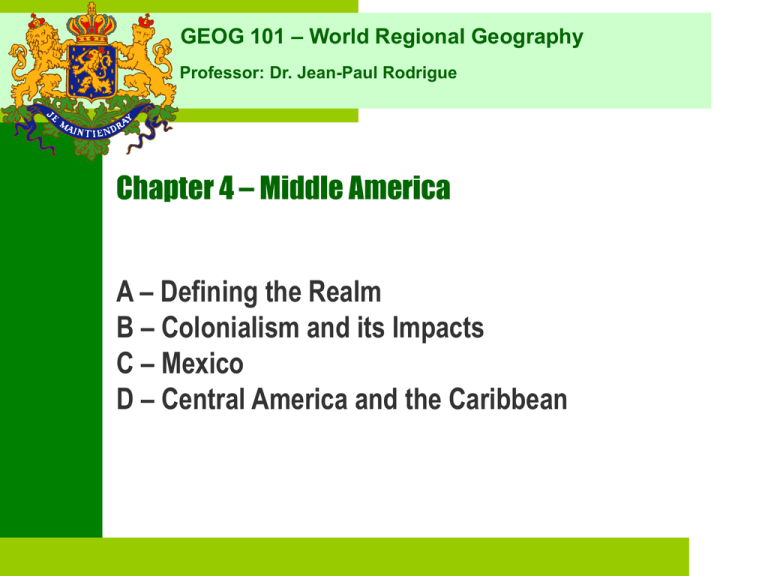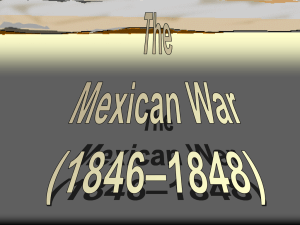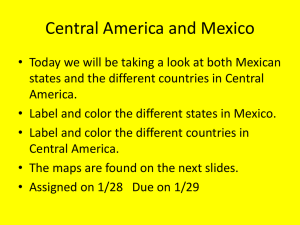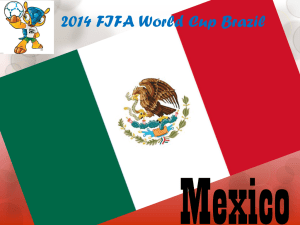Chapter 4 – Middle America
advertisement

GEOG 101 – World Regional Geography Professor: Dr. Jean-Paul Rodrigue Chapter 4 – Middle America A – Defining the Realm B – Colonialism and its Impacts C – Mexico D – Central America and the Caribbean A The Landscape ■ Defining the realm • Latin America: • Includes Middle and South America. • Mexico: • The most substantial landmass. • Central America: • Narrowing strip of land to 40 miles wide in Panama. • Caribbean islands. ■ Major geographic qualities • Fragmented - physically and politically. • Culturally diverse : • Less Latin than South America. • Importance of pre-Columbian and African cultures. • Many European dominions (English, French, Dutch). Physical Geography ■ Land bridge • A link (isthmus) between two major continental masses. • A shortcut between two major oceans. ■ Archipelago • About 7000 islands. • Greater Antilles: • The four large islands; Cuba, Hispaniola, Puerto Rico and Jamaica. • Lesser Antilles: • Numerous small islands; Bahamas, Martinique, etc. ■ Natural hazards • Earthquakes. • Volcanoes. • Hurricanes. Physical Geography ■ Volcanism Eruption of lava and rock fragments and gas explosions. Path of least resistance to the surface. Often corresponds to borders between tectonic plates. Magma bursts forth as lava in volcanic eruptions. Yields the classic cone-shaped or composite volcanoes that frequently associated with volcanic eruptions. • Montserrat: • • • • • • Major volcanic eruption in 1995; ongoing to 2003. • Evacuation of 7,000 out of the 10,500 population. • More than half the island now inhabitable. Tectonic Plates in Middle America North American Plate Caribbean Plate Pacific Plate Cocos Plate Physical Geography ■ Hurricanes • • • • Violent tropical storms. Form during the summer and early fall. About 96 tropical cyclones are reported annually. Spiral shape and curved paths: • • • • Caused by the Coriolis effect. Formed 5 degrees north and south of the equator. In the north, storms follow clockwise paths. In the south, storms follow a counterclockwise path. • Heat is the critical factor in the formation of tropical storms. World Hurricane Tracks Regions of Middle America Atlantic Ocean Lesser Antilles Greater Antilles Mexico Cuba Jamaica Belize Pacific Ocean Guatemala El Salvador Puerto Rico Haiti Dominican Republic Caribbean Sea Honduras Nicaragua Costa Rica Central America Panama Regional Divisions ■ Central America • • • • • • • From Guatemala to Panama. Geopolitically fragmented. Panama Canal zone controlled by the United States until 1999. Population of about 30 millions, mostly Métis. Plantation system often controlled by American multinationals. Exports of bananas, coffee, sugar and cotton. Dependency on the American market. Regional Divisions ■ Caribbean • Large number of Islands, about 35 million inhabitants. • Lesser Antilles; the crest of volcanic mountains. • Insular micro-states; no other equivalent in the world: • Other island states are groups of islands. • European and African influence: • Cuba: 70% White. • Haiti: 90% Black. • Dominican Republic: 60% Métis. • Important export functions: • Sugar for Cuba; Coffee, Sugar and Cacao for Hispaniola; Bauxite for Jamaica. • Tourism: • Important function. • Dependent on the United States (proximity). Mesoamerica ■ Culture hearths • Pre-Columbian Latin America was a combination of a few urbanbased federations ruled by the Mayas, Incas or Aztecs. • Maya civilization: • • • • 3000 BC. Classic period 200-900 AD with a population of 2-3 million. Lowlands; Honduras, Guatemala, Belize, Yucatan peninsula. Theocratic structure; collapsed by the 9th century. • Aztec civilization: • • • • 1300 AD. Highlands; Valley of Mexico. Tenochtitlan (Mexico City) with a population of more than 200,000 people. Overthrown by Cortes between 1519-21 with 508 soldiers. Pre-Columbian Civilizations in Middle America Atlantic Ocean Aztec Pacific Ocean Maya Colonial Experience ■ Conquista • • • • • Began in the early 1500s. First in the Caribbean (Hispaniola). Region divided into numerous individual colonial territories. Military phenomenon (muskets and horses). Lack of unity among indigenous groups (Aztecs, Incas) that the Spanish encountered. ■ Impact on the indigenous population • Scattered groups of people living in subsistence economies. • Diseases brought by the Europeans: • Decimated the indigenous populations to levels drastically lower those prior to the beginning of the invasion. • Latin American population fell from about 60 million in 1500 to 15 million in 1650. Colonial Experience ■ Land appropriation • Colonial commercial interests. • Lands devoted to food crops for local consumption were converted to cash cropping for export ■ Forced urbanization • Relocation of the population in nucleated towns and villages. • Favored control and conversion to Catholicism. ■ Land alienation • • • • Famine; loss of 90% of the population. Poverty. Migration. Little agricultural diversity. Colonial Experience ■ Religion • Major concern of the Europeans, especially of the Spanish. • Reconquista (1492): • Driving the last of the Moors from Spain. • Religious struggle as well as a nationalist one. • Religious fervor carried over into colonial activity as well. • Combination of religious activity with colonial expansion. • Religious conversion to Catholicism: • Occurred on a massive scale. • Religious infrastructure was among the early priorities of the colonial powers: churches, convents, cathedrals. • Presence of the Church is felt virtually everywhere in Latin America today. Colonial Experience • Catholicism mixed with indigenous religions: • Unique blend that carries a very strong stamp of the local culture. • Catholicism's plethora of saints and myths: • Served to make the conversion process itself go more smoothly. ■ Land ownership • Pre-Columbian Latin America: • Generally communal. • Concept of private ownership of land was alien to most of the groups. • Altered to meet the needs of the colonial economy that the Europeans established. • A primarily subsistence agricultural economy would produce very little surplus to exploit. Colonial Experience ■ Land alienation • Implementation of the encomienda: • • • • • • • A replicate of the European feudal system. System that mandated the payment of tributes to the Crown. Forced the indigenous groups into the cash economy. Subsistence agriculture would not provide the means to pay the tax. The Crown rewarded its conquistadores with huge land grants. Most provide protection and the teachings of Christianity. Including much land already used by the indigenous peoples. • Formation of large haciendas (estates): • Encomienda system ensured the presence of a large labor force that essentially was a slave labor force. • Workers derived little benefit from their labors beyond the ability to pay the encomienda. Land Tenure Systems Plantation Northern European origins Export oriented monocrops Imported capital and skills Seasonal labor Efficiency is key Single cash crop Profit motive Market vulnerability Hacienda Spanish institution Not efficient but social prestige Workers lived on the land Domestic market Diversified crops Year round jobs Small plot of land Self-sufficient Colonial Experience ■ Social stratification • Development of a socially stratified society along racial lines. • Miscegenation: • • • • • Mixed race resulting between Caucasians and the indigenous population. Miscegenation began very early on during the colonial period. Early migrations from Europe were primarily male migrations. Mestizos (Métis): European / Indian. Mulattos: European / Black. • In most cases continued into contemporary times. • One of the overriding realities of Latin America. • One of the region's greatest problems. Colonial Experience ■ Upper class • A small group controlling Latin American society. • Primarily comprised of people of European extraction. • Many of whom are directly descended from the original settlers of the Conquista. • Inherited the large landholdings from that era. ■ Middle class • Historically very small in Latin America: • Growing substantially in the post-WW II period. • Comprised of less wealthy Europeans, mestizos and mulattos. Colonial Experience ■ Lower class • Most numerous group in the region. • Remnants of unassimilated indigenous populations: • Particularly numerous in Guatemala, parts of Mexico (Oaxaca and Chiapas states), Ecuador, Peru, Bolivia, and parts of Brazil, Venezuela, and Paraguay • Work in great estates: • Often as sharecroppers. • Giving a negotiated percentage of their produce to the landowner, keeping the rest for family use or sale. • Descendents of African slaves: • Imported during the colonial period for their labor. • Numerous in much of Brazil, the Dominican Republic, and Cuba; and in some coastal areas of Colombia, Panama, and Mexico. Euro-African influence. High accessibility (trade). Plantation economy (Sugar and banana). Euro-Indian influence. Greater isolation. Hacienda prevailed. Mexico ■ Modern Mexico • High social stratification as with most of Latin America. • Once independence was achieved, despotism resulted, undermining progress. • The outcome of the 1910 revolution. • Aiming at redistributing land: • 8,000 haciendas taking almost all the good farmland. • 95% of rural families owning no land (peones). • Land distribution in a rural society still a major issue. • Substantial oil reserves controlled by the government. Importance of Mexico ■ Population issues • • • • • • • 106 million inhabitants. 60% Métis, 30% natives and 10% whites. Pre-Colombian heritage. Youthful population with an average age < 20. Opportunity to migrate to the USA - legally or illegally. Represented an outlet for Mexico's excess labor. Simultaneously fills a need in the US as Mexican workers willingly take jobs that most US citizens do not want. Mexican Migration to the United States ■ The Bracero Program (1943-1964) • From the Spanish “Brazos” meaning people working with their arms. • The Mexico-US migration pattern is recent (mid 20th century). • Established during WW II (1943): • Allowed Mexican farm workers to work temporarily on farms in Texas, California, and the Southwest USA. • Make up for the labor shortage caused by the war (the USA had over 11 million people in uniform). • The program worked well and helped both countries. • About 5 million Mexican immigrants entered the US. Mexican Migration to the United States • Reciprocity: • The USA got the labor it needed without making a permanent commitment to admit the workers as residents. • Took 10% of earnings to be deposited in saving accounts in Mexico. • To favor the return of labor. • Mexico earned foreign exchange: • Remittances sent back home by the workers and solved some of its own employment problems. • The third most important source of income for Mexico after oil and tourism. • 16.6 billion in 2004. Top 10 Countries of Origin for US Legal Immigrants, 1995-2003 0 50,000 100,000 150,000 200,000 Mexico India Philippines China, People's Republic El Salvador Dominican Republic Vietnam Colombia Guatemala Russia 1995 2000 2003 Population Pyramid of Mexico, 2000 80-84 Female Male 70-74 60-64 50-54 40-44 30-34 20-24 10-14 0-4 -6 -4 -2 0 Millions 2 4 6 !(!( !( !( !( Regions of Mexico !( !( !( !( !( San Diego !( Mexicali !( Phoenix !( !( Montgomery Dallas Jackson El Paso !( !( Baton Rouge Mexamerica !( Hermosillo !( La Paz !( Atlanta !( Chihuahua Saltillo !( !( Culiacan !( Austin San Antonio !( !( Houston Mobile New Orleans Galveston !( Monterrey !( Durango Club Mex Ciudad Victoria New Spain Mazatlan Zacatecas !( Tepic !( Aguascalientes !( Tampico !( !( Guadalajara Colima !( Tallahassee !( !( Metromex Toluca Merida Queretaro Morelia Campeche Pachuca !( !( Cuernavaca Mexico !( !( Jalapa Chetumal City!( Veracruz Chilpancingo De Los Bravo Oaxaca Acapulco !( Club Mex Villahermosa South Mexico !( !( Tuxtla Gutierrez La Ceiba San Pedro Sula !( Quezaltenango Guatemala Tegucigalpa !( !( Escuintla Santa Ana Choluteca San!( Miguel The Regions of Mexico ■ Mexamerica • Extends north of the Rio Grande into Texas, New Mexico, Arizona, and California. • Northern half of Mexico. • The most integrated with the US economically and culturally. • Source of most migration to the US. • Largely a dry land of great ranches. • Concentration of land ownership: • Runs counter to overall government policies, since the Revolution, of more equitable land distribution. The Regions of Mexico ■ New Spain • Mexico's breadbasket and its historic colonial hearth. • Region of old cities and tradition. • Most conservative and traditionally Catholic region. ■ Metromex • Mexico City and its surrounding area. • Classic example of a primate city: • One of the world's largest city (25 million). • A quarter of the national population. • Growing at the estimated rate of 500,000 per year through both natural increase and immigration. • Dominates the national economy, the national political life, and its modern cultural life. • Significant environmental problems. The Regions of Mexico ■ South Mexico • Major areas of continued habitation by large indigenous populations: • The states of Chiapas, Oaxaca, and of the Yucatán Peninsula. • 20% of the Mexican population of Amerindian origin. • Many unassimilated groups, particularly in highland areas. • The poorest region of the country. • Least affected by development. • Chiapas rebellion of 1994: • Revolt against landowners. The Regions of Mexico ■ Club Mex • Capture the essential international flavor of Mexico's areas of concentrated resort tourism development. • Tourism as economic development: • • • • Pursued by the government. Mostly in areas of relatively limited industrial development. Created the necessary infrastructure (particularly airports). Allow foreign investors to have access to rather remote regions (note Cancún, Ixtapa, Puerto Escondido). • Construction of hotels, restaurants, and entertainment facilities. • Club Mex is much less Mexican than other parts of the country. Integration to North America ■ Context • Pool of cheap labor will be more readily exploitable by multinational corporations. • Improve Mexico's employment outlook by absorbing its young and growing labor force. • Stem the tide of migration by reducing the incentive to move to the USA. • Increase and diversify Mexico's export potential. • Increasing its ability to earn foreign exchange. • Reducing its risk of recession that was quite high when it relied primarily upon one export product - oil. Integration to North America ■ Creation of Maquiladoras • Initiated in the 1960s as coupon houses. • Assembly plants pioneered the migration of industries in the 1970s. • Importance: • 4,000 maquiladoras. • 1.2 million employees. • • • • • • Modern industrial plants. Assemble imported, duty-free components/raw materials Export the finished products Mostly foreign-owned (U.S., Japan) 80% of goods re-exported to U.S. Tariffs limited to value added during assembly Wages in the Manufacturing Sector, 1995 (per hour) Mexico Canada United States 0 5 10 15 20 Integration to North America ■ NAFTA (1994) • Trade agreement between Mexico, Canada and the US: • Reduced and regulated trade tariffs, barriers, and quotas. • Standardized finance & service exchanges. ■ Advantages • Mexico gains jobs. • Foreign owners benefit from cheaper labor costs. ■ Effects • Regional development. • Development of an international growth corridor between Monterrey and Dallas - Fort Worth. ■ Future • The model came to a standstill in the 21st century. • Labor competition from China ($0.35 to $1 per hour). • Loss of 300,000 jobs. Integration to North America (The Maquiladoras) California Los Angeles (15,000,000) San Diego Yuma (2,600,000) (55,000) Arizona Phoenix (2,300,000) Nogales (20,000) Tijuana (1,000,000) Mexicali (600,000) Nogales (110,000) Border industrial zone Southern Maquiladoras limit Transformation and trade city Industrial development Investments Semi-finished goods United States Albuquerque (400,000) New Mexico El Paso (520,000) Finished goods Semi-finished goods Texas Ciuadad Juarez (800,000) San Antonio (950,000) Houston Laredo (3,750,000) (110,000) Chihuahua (550,000) Mexico Dallas-Fort Worth (4,050,000) Nuevo Laredo (220,000) Reynosa (300,000) Brownsville (95,000) Matamoros (300,000) Integration to North America ■ Mexico and NAFTA • Promises a higher standard of living. • NAFTA creates more jobs for Mexicans as US companies begin to invest more heavily in the Mexican market. • Mexican exporters increase their sales to the US and Canada. • Canada remains as the United States’ largest export market. • Since 1977, Mexico has moved into second place (displacing Japan). • 85% of all Mexican exports now go to the United States. • 75% of Mexico’s imports originate in the United States. Altitudinal zonation: Middle & South America’s Vertical Climate Zones Altitudinal Zonation in Middle America Sea Level Tierra Caliente Tierra Templada Tierra Fria Tierra Nevada Central America and the Caribbean ■ Population distribution • Most in middle altitudes (Tierra Templada). • Along the Pacific Coast. • The Atlantic coast is less settled: • Lowlands. • Tropical rainforest; infertile soils. • Tropical storms. • Fast growth: • Population doubling to 80 million by 2030. Central America and the Caribbean ■ Political turbulence • Linked with American intervention (Monroe Doctrine): • Deter any further European efforts to colonize parts of the Americas following the independence of most of Latin America. • Include the America’s right to intervene in the internal affairs of hemispheric states in matters deemed of concern to US security. • Overthrown of democratically elected governments: • Perceived to be leaning towards communism. • Chile (1973) and Guatemala (1954) to install military dictatorships. • Supporting many repressive, authoritarian, though anti-communist regimes in the process. • “He’s a SOB but he is our SOB”. • Led to many rebellions, civil wars and massacres. • Successful revolt by Fidel Castro in Cuba (1954). Central America and the Caribbean ■ Deforestation • 3 million acres of woodland in Central America disappear each year. • Clearing of rural lands to accommodate meat production and export. • Rapid logging of tropical woodlands to meet global demands for new housing, paper, and furniture. • Population explosion: forests are cut to provide crop-raising space and firewood. Central America and the Caribbean ■ Tourism • Caribbean countries are of small size: • Limited agricultural potential. • Limited economic opportunities. • High costs of living. • Advantages: • State and regional economic options. • A clean industry. • Educational. • Disadvantages: • Disjunctive development. • Degrades fragile environmental resources. • Inauthentic representations of native cultures. ■ Central America Free Trade Agreement (CAFTA) • Signed in 2005. • Involves NAFTA and 6 large Middle American countries (Costa Rica, Dominican Republic, El Salvador, Nicaragua, Honduras and Guatemala). The Panama Canal ■ Context • Joins the Atlantic and Pacific oceans at the Isthmus of Panama: • From Cristobal on Limon Bay, an arm of the Caribbean Sea, to Balboa, on the Gulf of Panama. • Ranks as one of the greatest engineering works of all time. • Composed of three main elements: • Gatun Locks (Atlantic side). • Gaillard Cut (continental divide) • Miraflores Locks (Pacific side). • Dimensions: • Slightly more than 64 km long. • Minimum depth of 12.5 m and a minimum width of 91.5 m. • Prevents a 21,000 km detour around South America. • Handles about 12% of the American international seaborne trade. The Panama Canal Atlantic Ocean Atlantic Ocean Cristobal Colon Gatun Locks Gatun Dam Gatun Lake Panama Canal Railway Pedro Miguel Locks Miraflores Locks Gaillard Cut Balboa 8 4 0 8 Miles Panama City Pacific Ocean The Panama Canal ■ Early history • Interest in a short route from the Atlantic to the Pacific began with explorers of Central America the early 16th century: • In 1534, the Spanish surveyed the Panama region. • Was judged impossible. • The United States became interested in the canal building when gold was discovered in California in 1848. • French attempts: • French Geographical Society of Paris signed a treaty with Columbia (then the owner of the Province of Panama; 1878). • From 1879 to 1899, the French Canal Company undertook construction. • The project failed due mainly to financial problems and the technical difficulties of trying to build a sea level canal. The Panama Canal ■ American intervention • Panama revolt from Columbia (1903), supported by the United States. • Hay-Bunau-Varilla Treaty: • United States guaranteed the independence of Panama. • Perpetual lease on a 16-km (10 miles) strip with complete sovereignty. • Compensation of $10 million and an inflation-indexed annual compensation. ■ Construction • Constructed between 1904 and 1916. • Cost of $387 million (compensation to Panama and $40 million to purchase the previous project from the French Canal Company). • Under the authority of the U.S. Army Corps of Engineers. • 70,000 people worked on the project and about 5,600 died in the process. • Excavation of 143 million cubic meters of earth. • Sanitation of the entire canal area (mosquitoes; yellow fever and malaria). The Panama Canal ■ Operations and traffic • Under the jurisdiction of the Panama Canal Authority (1999): • Collect tolls on all ships crossing the canal. • A loaded ship pays about $2.57 per net ton. • The average toll is about $45,000. • Traffic: • • • • 13,000 ships transit the canal every year, (35 ships per day). Grains (43% of the traffic transited). Containers (11%) and petroleum products (10%). Loss of some of its strategic importance due to super-tankers. • Panamax standard: • Equals to 65,000 tons and a draft of 12 meters.







